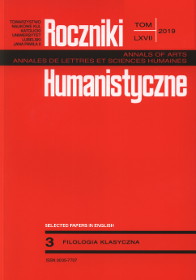Elements of the Mime in Horace’s Epode “Quid tibi vis, mulier”
Abstract
The Polish version of the article was published in Roczniki Humanistyczne vol. 61, issue 3 (2013).
The aim of this article is to discover the literary context for Horace’s Epode 12 by juxtaposing it with Herondas’ mimes, particularly Mime 5, titled The Jealous Woman. The description of the relationship between these works is based on the ancient theory of rhetoric and on elements of Horace’s Ars poetica. It has been established that Epode 12 has numerous features of the literary mime: it is an apparent dialogue (sermocinatio, παρῳδή) recited by a single performer (mime), most probably in the scenery of an ancient feast. A participant in the feast becomes an actor, who first performs the role of a male lover (iuvenis) and then the role of a superannuated female lover (mulier). These character types are typical of both Old and New Comedy styles, but the whole dramatic setting seems to bear the greatest resemblance to Mime 5, in which the same literary protagonists are found in a scene analogous to a lovers’ quarrel. On the one hand, specific rhetorical figures (imitatio / μίμησις) indicate that the literary original was used in a creative manner. On the other, Mime 5 can also be used in the interpretation of Epode 12. This interpretation can be built on the processes of liberation and subjugation as part of the lovers’ relationship (actual subjugation in Mime 5 and metaphorical—financial—in Epode 12, where the iuvenis is the mulier’s “kept man”).
References
Acronis et Porphyrionis Commentarii in Q. Horatium Flaccum. Edited by Ferdinandus Havthal. Berolini: Sumptibus Julii Springeri, 1864.
Barchiesi, Alessandro. “Horace and Iambos: The Poet as Literary Historian.” In Iambic Ideas. Essays on a Poetic Tradition from Archaic Greece to the Late Roman Empire, edited by Alberto Cavarzere, Antonio Aloni, and Alessandro Barchiesi, 141–164. Boston: Rowman and Littlefield Publishers, Inc., 2001.
Black, Max. “Metaphor.” Proceedings of the Aristotelian Society, New Series, Vol. 55 (1954–1955): 273–294.
Brill’s Encyclopedia of the Ancient World, edited by Hubert Cancik and Helmuth Schneider. Leiden–Boston: Brill, 2007.
Commager, Steele. The Odes of Horace. New Haven and London: Yale University Press, 1963.
Czerwińska, Jadwiga. “Graus methyse—anus ebria.” In Colloques, Congrés et Conférences sur la Renaissance Européenne 78, Le cabinet du curieux. Culture, savoirs, religion de l’Antiquité à l’Ancien Régime. Études et essais en l’honneur de Jean-Paul Pittion, edited by M. Kozluk and W.K. Pietrzak, 33–47. Paris: Éditions Classiques Garnier, 2013.
Diomedis Artis Grammaticae libri III. Edited by Heinrich Keil. In Grammatici Latini ex recensione Henrici Keilii, vol. 1 (abrev. CGL), Lipsiae: In Aedibus B.G. Teubneri, 1857.
Drwięga, Marek. Ciało człowieka. Studium z antropologii filozoficznej [The human body: A study in philosophical anthropology]. Cracow: Księgarnia Akademicka, 2002.
Hanusiewicz, Mirosława. Pięć stopni miłości [Five degrees of love]. Warsaw: Semper, 2004.
Harrison, Stephen J. “Some Generic Problems in Horace’s Epodes: Or, On (Not) Being Archilochus.” In Iambic Ideas. Essays on a Poetic Tradition from Archaic Greece to the Late Roman Empire, edited by Alberto Cavarzere, Antonio Aloni, and Alessandro Barchiesi, 165–186. Boston: Rowman and Littlefield Publishers, Inc., 2001.
Korus, Kazimierz. “Rzeczywistość w „mimach” Herondasa” [Reality in the mimes of Herondas]. Meander 9–10 (1994): 493–503.
Lausberg, Heinrich. Retoryka literacka. Podstawy wiedzy o literaturze [Literary rhetoric. Basic knowledge about literature]. Translated and edited by Albert Gorzkowski. Bydgoszcz: Homini, 2002.
Podręczny słownik terminów literackich [A concise dictionary of literary terms]. Edited by Janusz Sławiński. Warsaw: OPEN, 199912.
Quinn, Kenneth. Horace, The Odes. Hong Kong: Nelson, 1992.
Rostropowicz, Joanna. Odbicie rzeczywistości politycznej, społecznej i gospodarczej w poezji aleksandryjskiej [The reflection of political, social, and economic reality in Alexandrine poetry]. Warsaw–Wrocław: PWN, 1983.
Sielanka grecka [The Greek pastoral poem]. Translated by Anna Świderkówna, edited by Jerzy Łanowski. Wrocław: Zakład Narodowy im. Ossolińskich, 1953.
Tarn, William. Cywilizacja hellenistyczna [Hellenistic civilization]. Translated by Cezary Kunderewicz. Warsaw: PWN, 1957.
Vatsyayana, The Kama Sutra of Vatsyayana [ebook], trans. Richard Burton, Bhagavanlal Indrajit, Shivaram Parashuram Bhide, Gutenberg Project, 2009. Available at: https://www.gutenberg. org/files/27827/27827-h/27827-h.htm [Accessed 3 Oct. 2019].
Wilkinson, Lancelot Patrick. Horace and His Lyric Poetry. Cambridge: Cambridge University Press, 1968.
Watson, Lindsay C. “Epode 14: Horace’s Carmen Inconditum?” In Iambic Ideas. Essays on a Poetic Tradition from Archaic Greece to the Late Roman Empire, edited by Alberto Cavarzere, Antonio Aloni, and Alessandro Barchiesi, 187–204. Boston: Rowman and Littlefield Publishers, Inc., 2001.
Wójcik, Andrzej. Talent i sztuka. Rzecz o poezji Horacego [Talent and art: On Horace’s poetry]. Wrocław: Ossolineum, 1986.
Zarzycka-Stańczak, Krystyna. “Erotyki i sympotyki w drugim zbiorze Pieśni Horacego” [Erotic and sympotic poems in the second collection of Horace’s Carmina]. Roczniki Humanistyczne 23, no. 3 (1975): 59–72.
Zarzycka-Stańczak, Krystyna. “Kilka uwag o Pieśniach Horacego” [A few comments on Horace’s Carmina]. Roczniki Humanistyczne 16, no. 3 (1968): 93–106.
Zarzycka-Stańczak, Krystyna. “Pieśni miłosne Horacego” [Horace’s love songs]. Roczniki Humanistyczne 17, no. 3 (1969): 69–94.
Zarzycka-Stańczak, Krystyna. “Problematyka literacka w Satyrach Horacego” [Literary issues in Horace’s Satires]. Roczniki Humanistyczne 12, no. 3 (1964): 77–94.
Zarzycka-Stańczak, Krystyna. “Rola aluzji i reminiscencji literackich w Satyrach Horacego” [The role of literary allusions and reminiscences in Horace’s Satires]. Roczniki Humanistyczne 9, no. 2 (1960): 53–64.
Copyright (c) 2019 Roczniki Humanistyczne

This work is licensed under a Creative Commons Attribution-NonCommercial-NoDerivatives 4.0 International License.





